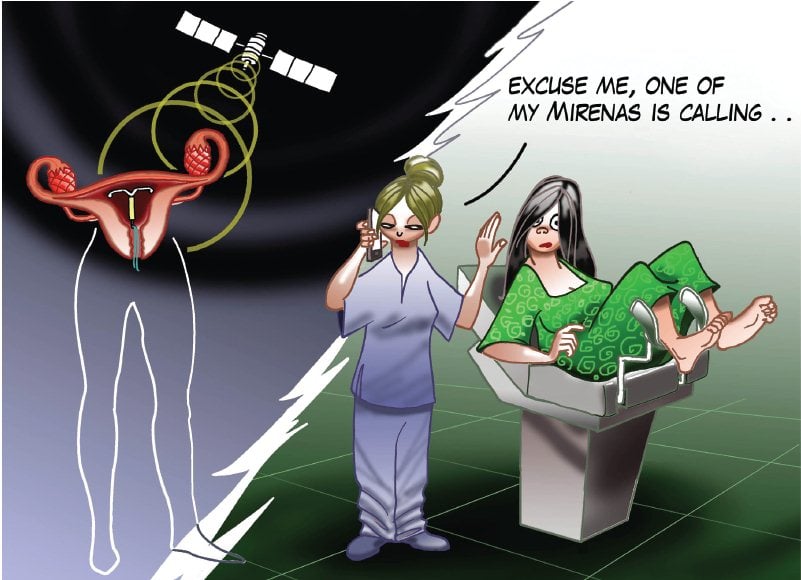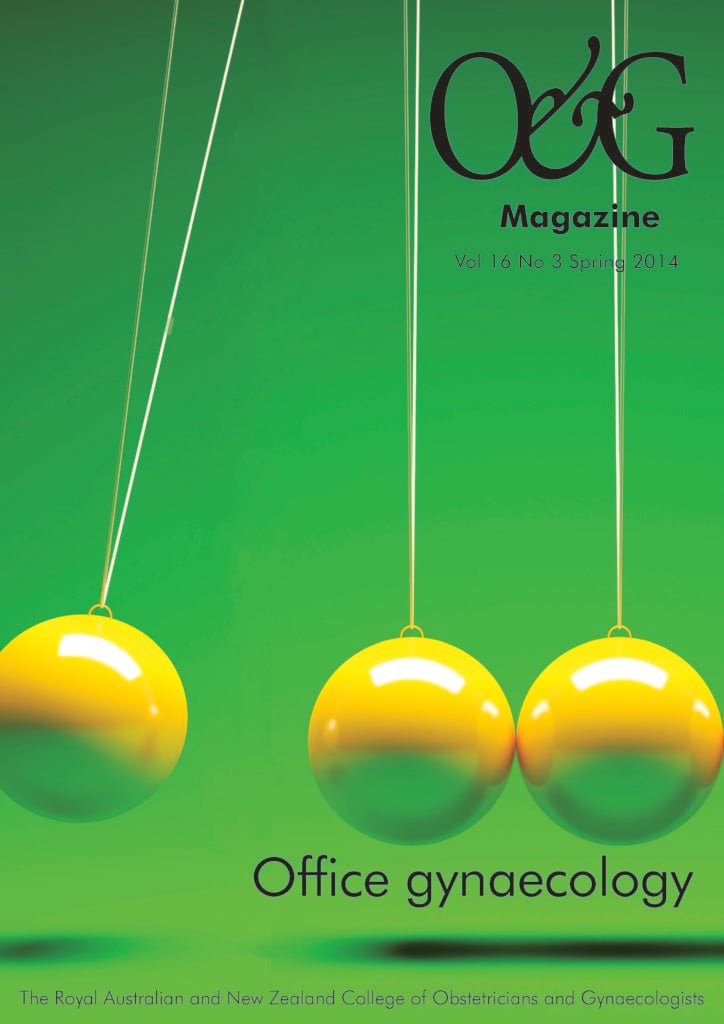The Mirena is widely used to treat myriad women’s health-related issues. With a flexible T-shaped plastic frame, it contains a cylinder of 52mg of levonorgestrel, which is released at small, metered doses of 12mcg daily for five years. It exerts its effect on the endometrium with minimal systemic progestogenic effects.
Use of the contraceptive intrauterine device (IUD), or variations thereof, dates back to the beginning of the 20th century. Dr Richter of Waldenberg, Germany, described the first genuine IUD in 1909. Two intricately woven strands of silkworm gut were capped with celluloid for intrauterine insertion to prevent injury to the endometrium. The threads at the vaginal end were bound by a thin bronze fragment to herald expulsion and to facilitate retrieval. In an era complicated by endemic gonorrhoea, and thus pelvic inflammatory disease (PID), with no adequate therapeutic treatment measures, IUDs were perceived to be considerable infection risks and hazardous methods of contraception.
The development of a more serviceable device was achieved in 1924, by Dr Ernst Grafenberg, a specialist obstetrician and gynaecologist. It was in the form of an IUD ring and was made of helically wound silver fragments. Damaging reports of IUD- associated PID later led to the German Congress of Gynaecology denouncing Grafenberg’s achievements as a medically unacceptable method of birth control. Interesting times.
The device lay dormant for nearly four decades, plagued by its reputation as an inciter of PID, until the first copper-bearing IUD was introduced in 1969. This solved the spatial and painful incompatibilities of previous models, and the T-shape was born. The expulsion rate was radically reduced.
Despite these advances in development, the predominant complaint of menorrhagia remained unaddressed by the copper-bearing devices. This led to the birth of the third-generation, progesterone-releasing IUD in 1977, which revolutionised the world of IUDs with its effect on progesterone receptors in the endometrium.
How does Mirena work?
Continuous low-dose release of levonorgestrel (LNG) has progestogenic effects on the uterine cavity, leading to physical and morphological changes. Thickened cervical mucus provides a physical barrier to sperm penetration. It also inhibits sperm capacitation and survival. The morphological changes include stromal pseudo-decidualisation, glandular atrophy, leukocytic infiltration and a reduction in glandular and stromal mitoses.
Ovulation is maintained in approximately 85 per cent of women using the LNG-IUD. Complete ovulation suppression requires a daily intrauterine concentration of 50mcg LNG, significantly greater than the elution level of this device.
What are the indications?
International consensus has been achieved through multiple randomised control trials (RCTs) and systematic reviews in recognising the use of the LNG-IUD as an effective form of contraception. Published data reveal that the cumulative five-year pregnancy rate is 0.7 per cent, deeming the device as effective as male/female sterilisation techniques. RANZCOG endorses the use of the LNG-IUD as a safe and highly effective method of contraception for use in women of all ages and parity.
The use of the LNG-IUD in the treatment of menorrhagia enjoys statistically proven superiority in reducing 97 per cent of the mean menstrual blood loss (MBL). Comparable results are not achievable with alternative medical therapies, including tranexamic/mefenamic acid, combined oral contraceptive pill (COCP) or gonadotrophin releasing hormone (GnRH) analogues.
The LNG-IUD provides an effective option for the treatment of menorrhagia, with avoidance of the risks associated with a surgical procedure and without permanent loss of fertility.
The Faculty of Family Planning and Reproductive Health Care Clinical Effectiveness Unit (FFPRHC) in the UK provides guidance and information to clinicians and women on evidence-based practice in women’s health. The recommendations regarding the LNG-IUD report it is as effective as conservative surgery (resection or ablation) in the management of menorrhagia after the first year of treatment.2
Other benefits
- Progestogenic HRT and effect on lipid metabolism in post-menopausal women: the LNG-IUD is effective in providing endometrial protection from stimulatory effects from oral and transdermal oestrogen, thereby reducing the risk of hyperplasia and malignancy.
- When used in conjunction with oestrodiol, it has proven cardio-protective qualities by maintaining baseline HDL levels after 12 months of treatment. Similarly LDL-cholesterol levels are reduced.
- Endometriosis: prospective studies report an 80 per cent reduction is primary dysmenorrhoea and MBL in women with a diagnosis of endometriosis.
- Fibroids: the LNG-IUD provides improvement in fibroid related menorrhagia and dysmenorrhoea, and also boasts a documented reduction in fibroid volume.
- Treatment of early endometrial hyperplasia: there is proven efficacy in treatment of endometrial hyperplasia owing to anti-proliferative and suppressive effects on the endometrium.
- Prevention of PID: a large European multi-study RCT (Luukainen, 1987) demonstrated a significantly lower incidence of PID and subsequent long-term protective effect in LNG IUD users than with other IUD users.
- Ectopic pregnancy: there is a reported annual incidence of 0.1 per cent ectopic pregnancy in women with a LNG IUD in situ. The use of the device is not contraindicated in women with a history of previous ectopic pregnancy as it does not increase the incidence of recurrence (WHO classification Category 1: Unrestricted use).
- It is safe for use in breastfeeding mothers after four weeks postpartum and beyond.
- Use in women with a history of migraine with focal symptoms also appears appropriate.
- As a long-acting reversible contraceptive (LARC), it carries a five-year licence.
- It is reversible and allows rapid return of fertility.
- There is no evidence of any detrimental effect on bone mineral density (BMD).
What are the contraindications and complications?
There are some contraindications to consider. They include:
- pregnancy;
- acute PID – it is imperative to ensure a minimum period of three months post effective treatment before insertion of the IUD;
- congenital or acquired distortions of the uterine cavity (fibroids, septae);
- postpartum endometritis after three months;
- uterine or cervical neoplasia;
- progestin-sensitive breast cancer;
- uterine bleeding of unknown aetiology;
- acute liver disease or liver tumour (benign or malignant);
- a previously inserted IUD that has not been removed; and
- a hypersensitivity reaction to IUD product components.
Patients should be counselled about the following possible complications:
- Ovarian cysts: risk 1.2 per 100 women-years (eight per cent); 94 per cent are asymptomatic, small and self-resolving.
- Unscheduled vaginal bleeding: irregular bleeding/spotting in the first three-to-six months is common.
- Systemic hormonal side effects: oedema, weight gain, headache, acne, hirsutism and breast tenderness.
- Failure rate: less than one per 100 women years; 4.5 per cent risk of expulsion over five-year duration.
- Insertion complications; risk of uterine perforation <0.1 per cent; more difficult/uncomfortable insertion in nulliparous women (Society of Family Planning, 2009).
- Uterine abnormalities: not recommended if fibroids distort the uterine cavity or if a congenital abnormality of the uterus is known.
Is it cost effective?
Analyses of LARC measures have been conducted comparing the cost-effectiveness ratios of LNG-IUD, copper IUD, depot medroxyprogesterone acetate injection (DMPA) and oestrogen subdermal implant. These methods were also compared to the COCP and female sterilisation techniques.
The studies included contraceptive provision and equipment costs, health professionals’ counselling, insertion and removal time. Consideration of the total number of unintended pregnancies resulting from contraceptive failure or discontinuation was similarly evaluated for each method.
LARC methods were proven to be more cost-effective than COCP, reducing the number of unintended pregnancies and thereby generating net cost-savings for up to six years. Beyond six years, female sterilisation procedures proved to be more cost effective than LARC methods as they provided 100 per cent compliance and a low failure rate.
The Mirena is PBS listed, at a cost of $36.90 for five years’ duration. It is an extremely cost-effective means of contraception and control of dysfunctional uterine bleeding.

This scenario is not as far-fetched as it may, at first, seem.
What does the future hold?
The UN strategy for Women and Children’s Health was founded in 2012, and focuses on the global expansion and access to family planning services and facilities for women and girls in the developing world. Family Planning 2020 aims to build new partnerships and new commitments to enable an additional 120 million women from the world’s poorest countries to access modern contraception by the year 2020. The introduction of the LNG-IUD to such outreach populations has the potential to offer long-lasting and highly effective means of contraception. Ensuring the supply of appropriate equipment, education and user-competency is essential in the success of such a project. These goals can be implemented through mobile outreach services including the Marie Stopes Foundation, which has access to highly populated sub-Saharan African communities.
Have you ever considered remotely controlled or monitored contraception? A 1.5cm-wide microchip housing reservoirs of the hormone LNG has been submitted for clinical testing in the USA. A small electric charge melts a thin seal housing the LNG, releasing a 30mcg daily dose. The microchip can remain in situ for a period of 16 years. Controlled remotely, it and can be activated and deactivated at times of convenience, particularly when planning a family.
Just imagine: you could receive encrypted data from your patient’s Mirena on your iPhone, warning of malfunction, impending failure or low elution levels. The future is both challenging and bright. Be sure to keep abreast.
References
- Bina I. The Role of Mirena, Other than Contraceptive Benefits: Current Concepts and Practices. J Bangl College of Phys and Surg. 2010 September; 28 (3):167-173.
- Faculty of Family Planning and Reproductive Health Care (FFPRHC). FFPRHC Guidance (April 2004). The Levonorgestrel-releasing intrauterine system (LND-IUS) in contraception and reproductive health. J Fam Plann Reprod Health Care 2004; 30(2):99-109.
- Mavranezouli I. The cost-effectiveness of long-acting reversible contraception methods in the UK: analysis based on a decision-analytic model developed for a National Institute for Health and Clinical Excellence (NICE) clinical practice guidelines. Hum Reprod. 2008 Mar 26; 23 (6):1338-1345.
- Thiery M. Pioneers of the Intrauterine device. The European J Contraception and Reprod Health Care. 1997; 2 (1):15-23.
- A bright future for IUD use in Africa. Global Health: Science and Practice. 2014; 2 (1):3.






Leave a Reply